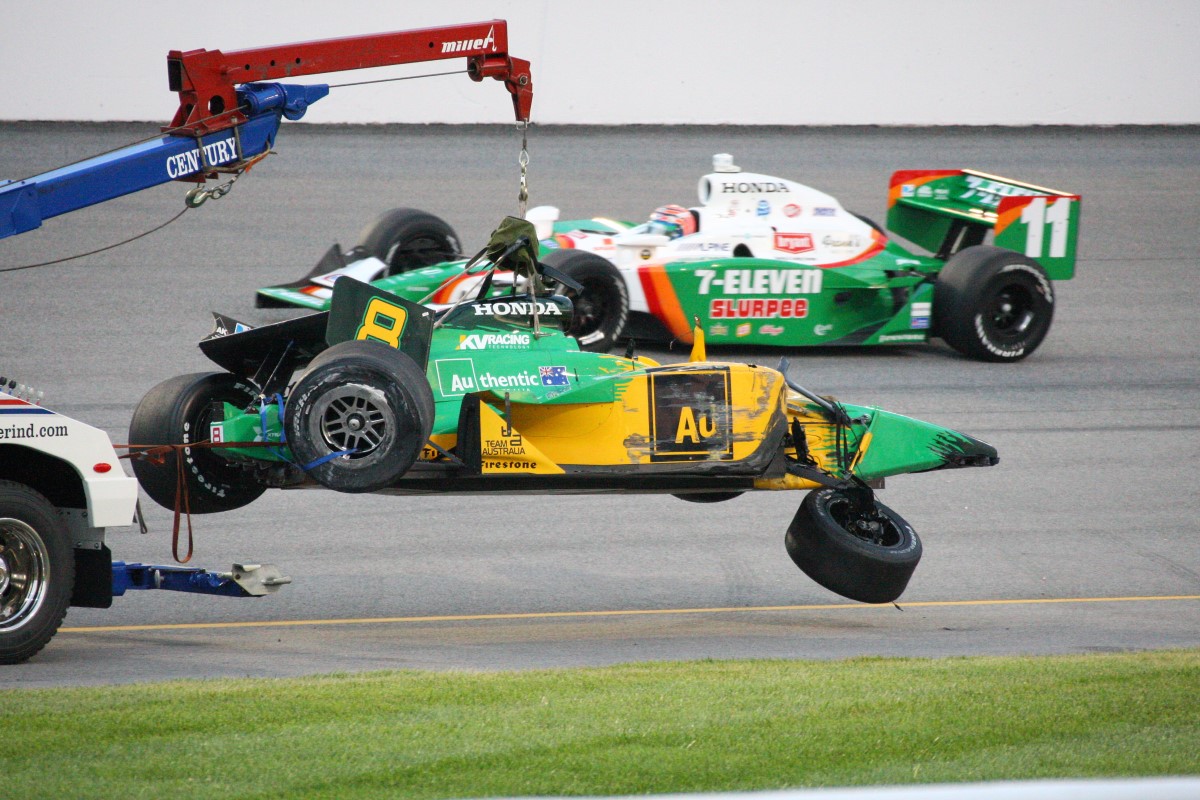Richmond newspaper slams IndyCar crashfest
 |
| The Mickey Mouse Richmond track cost the IndyCar teams a lot of money in mangled equipment Saturday night |
| Shawn Payne/IRL |
Races sometimes end under caution. Seldom do they begin under caution.
But last night in the SunTrust Indy Challenge, the command, "Lady [Danica Patrick] and gentlemen, start your engines", quickly became, "Lady and gentlemen, please slow down."
The 26 cars in the IndyCar field had not completed one lap when Ryan Hunter-Reay spun out in Turn 4, and the first of nine caution flags of the evening came out.
That might not be what the fans came to see. It certainly wasn't what the drivers wanted. But all could say they were present when history was made.
The nine cautions set a record for this race at the Richmond International Raceway.
Tony Kanaan was the winner, but the best driving might have been done by the pace car. After all, 102 of the 300 laps were driven under caution.
In the plus column, that did save considerable fuel.
Score one for the IRL over the oil companies.
When the last lap was driven, more cars, 14, were off the track than on, 12.
This wasn't so much a race as it was a matter of survival.
"It was hard to drive out there," said Vitor Meira, out after Lap 79. "I don't know what was going on."
Ah, but he did.
"It was lack of grip," Meira said of the cars' tires. "This lack of grip doesn't allow us to race. I don't know where that comes from, whether it's the tires or weather or aero [aerodynamics], I don't know. The restarts were hard. The back tires kept spinning.
"It was really tough. Richmond used to be the most fun track. It's not anymore. It's becoming a boring race."
But one driver's idea of boring is another driver's idea of exciting.
"If we didn't have that much yellow, it would have been a boring race," said Helio Castroneves, who finished second. "It would have been follow the leader and nobody passes."
Castroneves and Meira both were right.
Without the early cautions, Kanaan would have driven away with the race. He started on the pole, opened a lead, and no one was gaining ground on him. He looked as if he could have driven to Watkins Glen, the site of the next IRL race, and no one would have caught him.
That wouldn't have been boring for Kanaan, but it would not have been dynamic racing either.
Then, cars began going into the wall and into each other. Out came the yellow flags, and the race became a comedy of errors.
Meira said it wasn't because of the drivers.
"We are the same very race," he said. "We don't all of a sudden come to a race and get crazy. Something triggered that, and I think it's lack of grip. That narrows the window for a mistake quite a lot, and when you narrow the window for mistakes, more mistakes show."
Hunter-Reay, who suffered the embarrassment of not getting through one lap before spinning out, had an explanation for why that happened.
It was the tires.
"Firestone gives us great tires every weekend," he said. "I think they experimented with a certain compound [tonight], and it just was not working."
His problems on the first lap, he said, were the result of, "Cold tires and too hard of a compound. The same thing happened to a lot of guys. It was everywhere."
The yellow tinge to the evening was evidence of that. But was it the tires?
Mark Robinson, a Firestone spokesman, said the company did change the tires from those used last year at RIR.
"Some drivers complained . . . the tire would degrade," Robinson said. "The tires were too soft.
"The tires were a little harder this year than last year. Hopefully, the drivers can adapt."
As for Hunter-Reay's first-turn problems, Robinson could only note that, "Twenty-five of 26 guys got through the turn OK."
Most of the drivers did not get through laps two through 300 quite as well, though. But at least this can be said of last night's race — it didn't finish under caution. Richmond Times Dispatch
